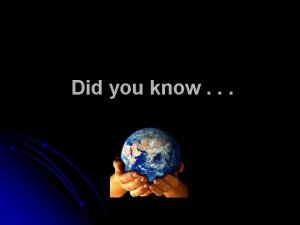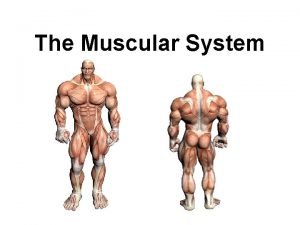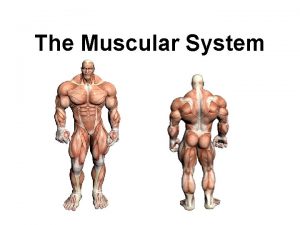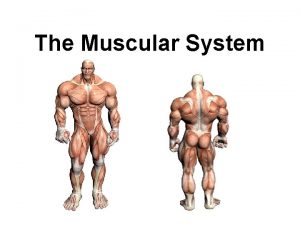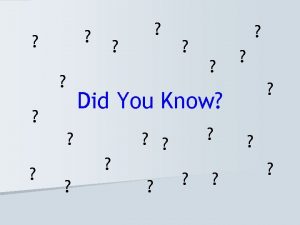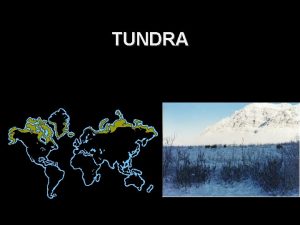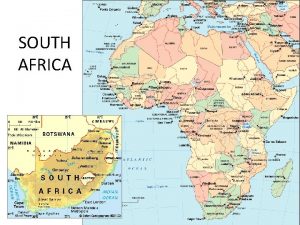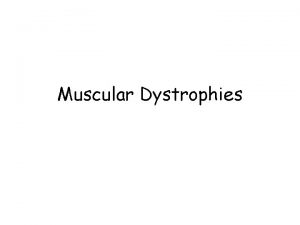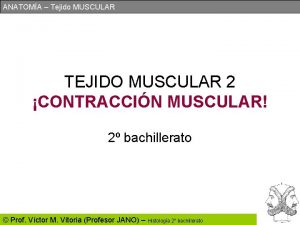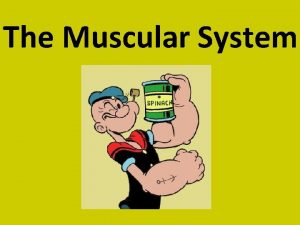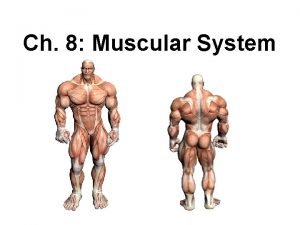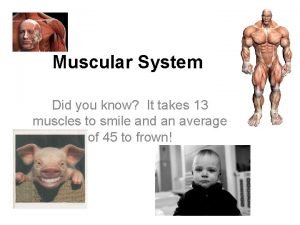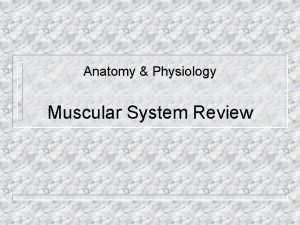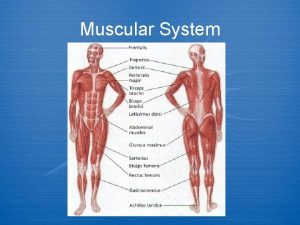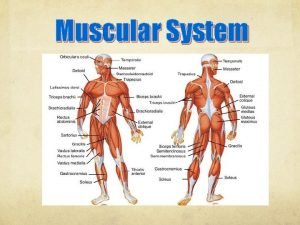The Muscular System Did you know that more























- Slides: 23

The Muscular System

Did you know that ? - more than 50% of body weight is muscle !



Three types of muscle Skeletal Cardiac Smooth

Classification of Muscle Skeletal. Cardiac. Smoothfound in limbs found in heart Found in viscera Striated, multi Not striated, 1 - nucleated -nucleated nucleus voluntary involuntary

Skeletal muscle • • • Large muscles Maintain posture Facilitate locomotion Move jointed bones Found in antagonistic pairs Joined to bones by tendons

Structure of skeletal muscle • • Each cell (fibre) is long and cylindrical Muscle fibres are multi-nucleated Typically 50 -60 mm in diameter, and up to 10 cm long The contractile elements of skeletal muscle cells are myofibrils

Skeletal muscle - Summary • • • Voluntary movement of skeletal parts Spans joints and attached to skeleton Multi-nucleated, striated, cylindrical fibres

Cardiac muscle • • • Main muscle of heart Pumping mass of heart Critical in humans Heart muscle cells behave as one unit Heart always contracts to it’s full extent

Structure of cardiac muscle • • Cardiac muscle cells (fibres) are short, branched and interconnected Cells are striated & multi-nucleated Adjacent cardiac cells joined via electrical synapses (gap junctions) These gap junctions appear as dark lines when viewed under LM, and are called intercalated discs

Cardiac muscle - Summary • • • Found in the heart Involuntary rhythmic contraction Branched, striated fibre with single nucleus and intercalated discs

Smooth muscle • Lines walls of viscera • Found in longitudinal or circular arrangement • Alternate contraction of circular & longitudinal muscle in the intestine leads to peristalsis

Structure of smooth muscle • • • Spindle shaped uni-nucleated cells Striations not observed Actin and myosin filaments are present Ratio of thin-to-thick filaments is 16: 1 (in striated muscle this is 2: 1) Myosin filaments are attached to dense bodies at the end of each cell

Smooth muscle - Summary • • • Found in walls of hollow internal organs Involuntary movement of internal organs Elongated, spindle shaped fibre with single nucleus

Muscle Control Type of muscle Nervous control Type of control Example Skeletal Controlled by CNS Voluntary Lifting a glass Cardiac Regulated by ANS Involuntary Heart beating Smooth Controlled by ANS Involuntary Peristalsis







 Lirik lagu more more more we praise you
Lirik lagu more more more we praise you More more more i want more more more more we praise you
More more more i want more more more more we praise you 5 apples in a basket riddle
5 apples in a basket riddle The more you study the more you learn
The more you study the more you learn Differentiate muscular strength from muscular endurance
Differentiate muscular strength from muscular endurance Like a rushing wind jesus breathe within
Like a rushing wind jesus breathe within You
You Phân độ lown
Phân độ lown Block xoang nhĩ độ 2 type 1
Block xoang nhĩ độ 2 type 1 Thể thơ truyền thống
Thể thơ truyền thống Thơ thất ngôn tứ tuyệt đường luật
Thơ thất ngôn tứ tuyệt đường luật Walmart thất bại ở nhật
Walmart thất bại ở nhật Tìm vết của đường thẳng
Tìm vết của đường thẳng Con hãy đưa tay khi thấy người vấp ngã
Con hãy đưa tay khi thấy người vấp ngã Tôn thất thuyết là ai
Tôn thất thuyết là ai Gây tê cơ vuông thắt lưng
Gây tê cơ vuông thắt lưng Sau thất bại ở hồ điển triệt
Sau thất bại ở hồ điển triệt Good teapot vs bad teapot
Good teapot vs bad teapot Cambios en reported speech
Cambios en reported speech Do you know about minecraft
Do you know about minecraft Did you know
Did you know Complete the questions about last weekend
Complete the questions about last weekend Suffix of friendship
Suffix of friendship Retail shrinkage statistics
Retail shrinkage statistics




















